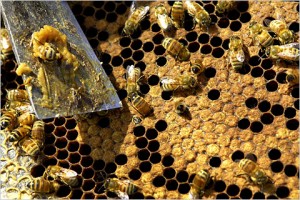
Photo Courtesy of Associated Press: A beekeeper scrapes rotten honey out of a hive recently affected by CDC.
Nathan Crites-Herren
The Paw Print
Over one-third of America’s food crop and countless other flowering plants have relied on an age old biological tradition, pollination. At the helm of this essential process ensuring the future of flora has always been the honey bee, engaging in the sacred ritual which is the creation of new life.
Honey bees pollinate by combing over blossoms searching for yellow pollen grains which they then transfer into small depressions on their hind legs. Throughout their flight they visit a plethora of plants, transferring pollen to the stigma of the same or different plant, allowing it to set fruit. Honey bees use the pollen to produce a highly concentrated protein source, honey.
This ancient dance between honey bees and pollination has become a billion dollar industry with the rise of agro-business and monoculture framing practices. According to the National Resource Defense Council, pollination by honey bee is responsible for the production of $15 billion worth of American crops. Every season thousands of beekeepers truck their hives some numbering in the thousands across the U.S. dropping them off in the east coast for pollination of nut trees then to the north west to pollinate clover fields then finally to the west coast pollinating fruit fields and orchards.
One-third of the food we eat comes from crops that need animal pollinators, a role often filled by honey bees. Bee-pollinated foods include squash, tomatoes, peppers, apples and pears to name a few. Focusing on the Valley, honeybees are essential for the growth of alfalfa hay a staple crop in the region that is becoming a dire need for livestock communities throughout the southwest.
Since 2006 the increasingly important honeybee population has been under siege from an enemy that has many different faces. Colony Collapse Disorder (CCD) has devastated honey bee populations throughout the U.S., leaving bee keepers, ranchers and farmers desperate for solutions. CDC is different from other diseases that cause the decline of bee colonies, its onset is rapid and the consequences result in complete destruction of entire colonies.
CDC is characterized by the complete disappearance of worker-bees from their colony, leaving the queen bees alone which ultimately devastates the colony. The bees that are infected with CDC seem to have behavioral defects that inhibit them from collecting pollen properly resulting in a drop in honey production. Within a week a healthy colony can be completely destroyed by CDC, a trend that has made this disorder into an epidemic.
The official scientific cause of CDC is unknown, at least according to the United States Department of Agriculture (USDA). However, independent scientist, bee keepers, farmers and ranchers have identified the culprit, mono-cropping and the pesticide industry.
Mono-cropping changed the family farm model of biological diversity to one relying on homogenized crops grown with heavy pesticides and absent of any crop rotation. Mono-cropping increased profits for big agro-business, allowing for continual planting of the same field with the same crop with the help of pesticides and herbicides. Any time a mono-crop is established in a field tremendous amounts of bio-diversity is lost, which in turn decreases bee population in that area because that field which used to have diverse amounts of flora only contains one type of plant, making that area un-attractive to bees.
Mono-cropping combined with the use of clothianidin, a pesticide used to coat seeds that prevents worm rot is the one-two combination which brings about CDC. Independent laboratory studies on clothianidin have linked it to causing paralysis of worker bees as seen in CDC.
The symptoms take time to develop up to a year in some cases, causing birth defects which carry the disease to a new generation of honey bees. Pesticides like clothianidin combined with the growing practice of mono-cropping have helped create and exacerbate the CDC epidemic by destroying natural habitat for wild bees and creating toxic environments for farmed honeybees.
Bee keepers, farmers and ranchers took their concerns over clothianidin to the USDA, only to get the usual lip service. The USDA, solely relying on the scientific research of the very Pesticide companies that are in question, determined that clothianidin shows no evidence of harming honey bee populations.
The incompetence of the USDA to see the inadequacy of a blatantly biased study which only observed bee behavior through a week of exposure to clothianidin only demonstrates the ownership of the USDA by pesticide and agro business.
The quest for profit in this capitalistic system knows no ends even when it comes to food security. As honey bee populations continue to dwindle in the coming seasons, we will see more problems with the success of farms to produce crops that require pollination.
In turn requiring more imports from other countries to fulfill our growing demand for produce. The already drastically cut bee population in the U.S., combined with the CDC outbreak are very real warning sings to a bleak future not only for bee keepers, farmers and ranchers but society as a whole.
In the near future we could very well live in a world that sees our grocery stores with a very different produce department, one that is absent of over half of all vegetables and fruits available today. If the bees are in trouble, then humanity is most definitely in trouble. Unfortunately most Americans are blind to this issue, meaning that we will see more of the same as the agro and pesticide business tightens its grip on our nation’s food production.
If you want to help bring the bees back, start an organic garden or plant a flower bed this year, future generations will thank you.
What’s Been Said…